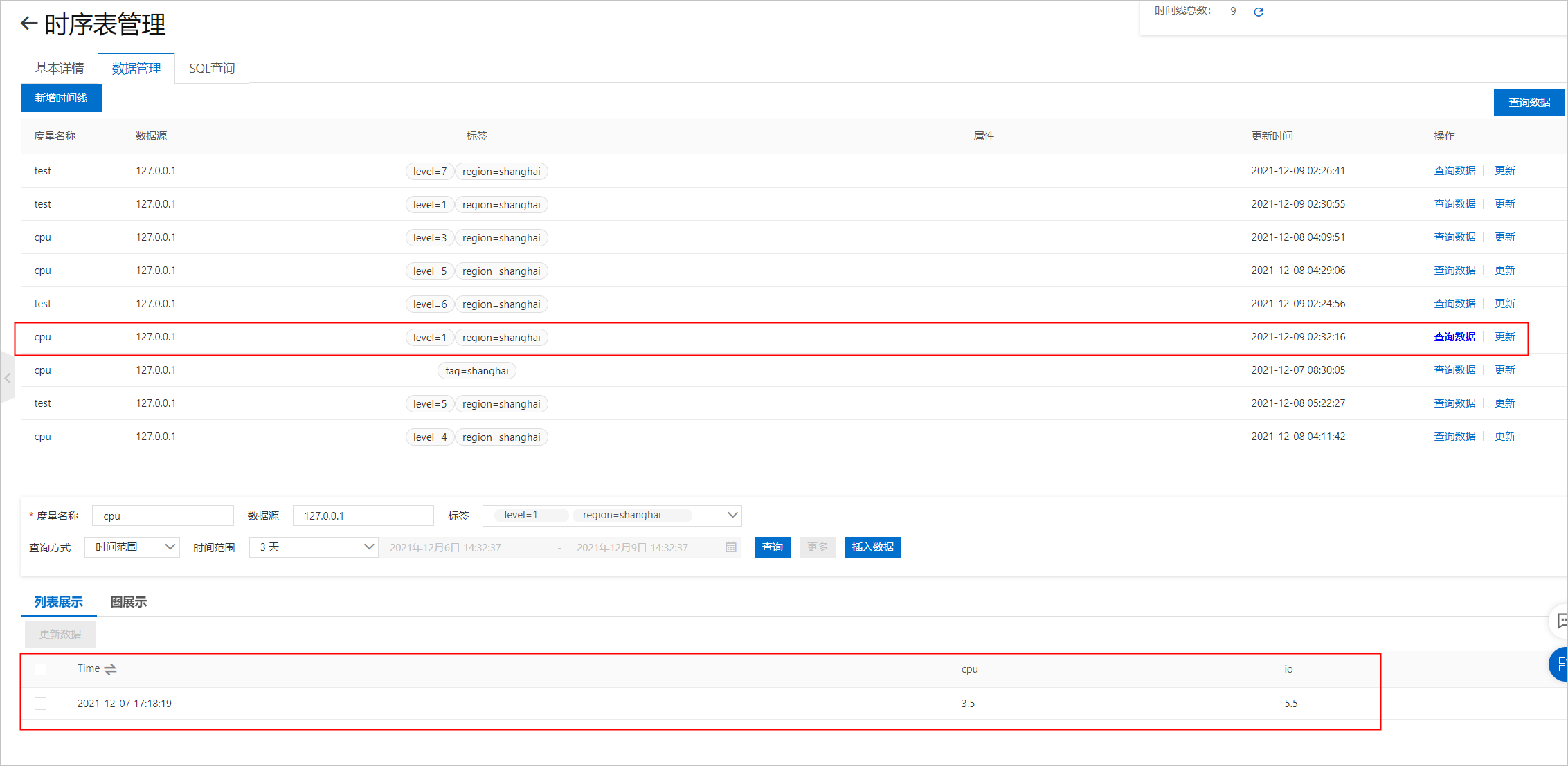您可以使用kafka-connect-tablestore包将Kafka中数据写入Tablestore的时序表中。本文主要介绍了如何配置Kafka写入时序数据。
前提条件
已安装Kafka,并且已启动ZooKeeper和Kafka。更多信息,请参见Kafka官方文档。
已开通表格存储服务,创建实例以及创建时序表。具体操作,请参见时序模型快速入门。
说明您也可以通过Tablestore Sink Connector自动创建目标时序表,此时需要配置auto.create为true。
已获取AccessKey。具体操作,请参见创建AccessKey。
背景信息
表格存储支持对时序数据进行存储以及分析。更多信息,请参见时序模型概述。
步骤一:部署Tablestore Sink Connector
通过以下任意一种方式获取Tablestore Sink Connector。
通过GitHub下载源码并编译。源码的GitHub路径为Tablestore Sink Connector源码。
通过Git工具执行以下命令下载Tablestore Sink Connector源码。
git clone https://github.com/aliyun/kafka-connect-tablestore.git进入到下载的源码目录后,执行以下命令进行Maven打包。
mvn clean package -DskipTests编译完成后,生成的压缩包(例如kafka-connect-tablestore-1.0.jar)会存放在target目录。
直接下载编译完成的kafka-connect-tablestore压缩包。
将压缩包复制到各个节点的$KAFKA_HOME/libs目录下。
步骤二:启动Tablestore Sink Connector
Tablestore Sink Connector具有standalone模式和distributed模式两种工作模式。请根据实际选择。
由于写入时序数据时,Kafka侧的消息记录必须为JSON格式,因此启动Tablestore Sink Connector时需要使用Jsonconverter,且不需要提取schema以及不需要输入key,请在connect-standalone.properties和connect-distributed.properties中按照如下示例配置对应配置项。
如果输入了key,请按照key的格式配置key.converter和key.converter.schemas.enable。
value.converter=org.apache.kafka.connect.json.JsonConverter
value.converter.schemas.enable=false此处以配置standalone模式为例介绍,distributed模式的配置步骤与同步数据到数据表时的distributed模式配置步骤类似,只需按照上述示例在worker配置文件connect-distributed.properties中修改对应配置项以及在connector文件connect-tablestore-sink-quickstart.json中修改时序相关配置即可。具体操作,请参见步骤二:启动Tablestore Sink Connector中distributed模式的配置步骤。
standalone模式的配置步骤如下:
根据实际情况修改worker配置文件connect-standalone.properties和connector配置文件connect-tablestore-sink-quickstart.properties。
worker配置文件connect-standalone.properties的配置示例
worker配置中包括Kafka连接参数、序列化格式、提交偏移量的频率等配置项。此处以Kafka官方示例为例介绍。更多信息,请参见Kafka Connect。
# Licensed to the Apache Software Foundation (ASF) under one or more # contributor license agreements. See the NOTICE file distributed with # this work for additional information regarding copyright ownership. # The ASF licenses this file to You under the Apache License, Version 2.0 # (the "License"); you may not use this file except in compliance with # the License. You may obtain a copy of the License at # # http://www.apache.org/licenses/LICENSE-2.0 # # Unless required by applicable law or agreed to in writing, software # distributed under the License is distributed on an "AS IS" BASIS, # WITHOUT WARRANTIES OR CONDITIONS OF ANY KIND, either express or implied. # See the License for the specific language governing permissions and # limitations under the License. # These are defaults. This file just demonstrates how to override some settings. bootstrap.servers=localhost:9092 # The converters specify the format of data in Kafka and how to translate it into Connect data. Every Connect user will # need to configure these based on the format they want their data in when loaded from or stored into Kafka key.converter=org.apache.kafka.connect.json.JsonConverter value.converter=org.apache.kafka.connect.json.JsonConverter # Converter-specific settings can be passed in by prefixing the Converter's setting with the converter we want to apply # it to key.converter.schemas.enable=true value.converter.schemas.enable=false offset.storage.file.filename=/tmp/connect.offsets # Flush much faster than normal, which is useful for testing/debugging offset.flush.interval.ms=10000 # Set to a list of filesystem paths separated by commas (,) to enable class loading isolation for plugins # (connectors, converters, transformations). The list should consist of top level directories that include # any combination of: # a) directories immediately containing jars with plugins and their dependencies # b) uber-jars with plugins and their dependencies # c) directories immediately containing the package directory structure of classes of plugins and their dependencies # Note: symlinks will be followed to discover dependencies or plugins. # Examples: # plugin.path=/usr/local/share/java,/usr/local/share/kafka/plugins,/opt/connectors, #plugin.path=connector配置文件connect-tablestore-sink-quickstart.properties的配置示例
connector配置中包括连接器类、表格存储连接参数、数据映射等配置项。更多信息,请参见配置说明。
# 设置连接器名称。 name=tablestore-sink # 指定连接器类。 connector.class=TableStoreSinkConnector # 设置最大任务数。 tasks.max=1 # 指定导出数据的Kafka的Topic列表。 topics=test # 以下为Tablestore连接参数的配置。 # Tablestore实例的Endpoint。 tablestore.endpoint=https://xxx.xxx.ots.aliyuncs.com # 指定认证模式。 tablestore.auth.mode=aksk # 填写AccessKey ID和AccessKey Secret。如果使用aksk认证,则需要填入这两项。 tablestore.access.key.id=xxx tablestore.access.key.secret=xxx # 指定Tablestore实例名称。 tablestore.instance.name=xxx ## STS认证相关配置,如果使用STS认证,则下列各项必填。此外aksk还需要在环境变量中配置配入ACCESS_ID和ACCESS_KEY。 #sts.endpoint= #region= #account.id= #role.name= # 定义目标表名称的格式字符串,字符串中可包含<topic>作为原始Topic的占位符。 # topics.assign.tables配置的优先级更高,如果配置了topics.assign.tables,则忽略table.name.format的配置。 # 例如当设置table.name.format为kafka_<topic>时,如果kafka中主题名称为test,则将映射到Tablestore的表名为kafka_test。 table.name.format=<topic> # 指定Topic与目标表的映射关系,以"<topic>:<tablename>"格式映射Topic和表名,Topic和表名之间的分隔符为半角冒号(:),不同映射之间分隔符为半角逗号(,)。 # 如果缺省,则采取table.name.format的配置。 # topics.assign.tables=test:test_kafka # 是否自动创建目标表,默认值为false。 auto.create=true # 以下为脏数据处理相关配置。 # 在解析Kafka Record或者写入时序表时可能发生错误,您可以可通过以下配置进行处理。 # 指定容错能力,可选值包括none和all,默认值为none。 # none表示任何错误都将导致Sink Task立即失败。 # all表示跳过产生错误的Record,并记录该Record。 runtime.error.tolerance=none # 指定脏数据记录模式,可选值包括ignore、kafka和tablestore,默认值为ignore。 # ignore表示忽略所有错误。 # kafka表示将产生错误的Record和错误信息存储在Kafka的另一个Topic中。 # tablestore表示将产生错误的Record和错误信息存储在Tablestore另一张数据表中。 runtime.error.mode=ignore # 当脏数据记录模式为kafka时,需要配置Kafka集群地址和Topic。 # runtime.error.bootstrap.servers=localhost:9092 # runtime.error.topic.name=errors # 当脏数据记录模式为tablestore时,需要配置Tablestore中数据表名称。 # runtime.error.table.name=errors ##以下为时序表新增配置。 # connector工作模式,默认为normal。 tablestore.mode=timeseries # 时序表主键字段映射。 tablestore.timeseries.test.measurement=m tablestore.timeseries.test.dataSource=d tablestore.timeseries.test.tags=region,level # 时序表时间字段映射。 tablestore.timeseries.test.time=timestamp tablestore.timeseries.test.time.unit=MILLISECONDS # 是否将时序数据字段(field)的列名转为小写,默认为true。由于当前时序模型中时序表的列名不支持大写字母,如果配置为false,且列名中有大写字母,写入会报错。 tablestore.timeseries.toLowerCase=true # 是否将所有非主键以及时间的字段以field的形式存储在时序表,默认为true,如果为false,则只存储tablestore.timeseries.test.field.name中配置的字段 tablestore.timeseries.mapAll=true # 配置field字段名称,多个字段名称之间用半角冒号(,)分隔。 tablestore.timeseries.test.field.name=cpu # 配置field字段类型。取值范围为double、integer、string、binary和boolean。 # 当field中包含多个字段时,字段类型必须和字段名称一一对应。多个字段类型之间用半角冒号(,)分隔。 tablestore.timeseries.test.field.type=double
进入到$KAFKA_HOME目录后,执行以下命令启动standalone模式。
bin/connect-standalone.sh config/connect-standalone.properties config/connect-tablestore-sink-quickstart.properties
步骤三:生产新的记录
进入到$KAFKA_HOME目录后,执行以下命令启动一个控制台生产者。
bin/kafka-console-producer.sh --broker-list localhost:9092 --topic test配置项说明请参见下表。
配置项
示例值
描述
--broker-list
localhost:9092
Kafka集群broker地址和端口。
--topic
test
主题名称。启动Tablestore Sink Connector时默认会自动创建Topic,您也可以选择手动创建。
向主题test中写入一些新的消息。
重要如果要导入数据到时序表,则向主题中写入数据时必须输入JSON格式的数据。
{"m":"cpu","d":"127.0.0.1","region":"shanghai","level":1,"timestamp":1638868699090,"io":5.5,"cpu":"3.5"}登录表格存储控制台查看数据。

